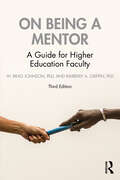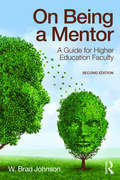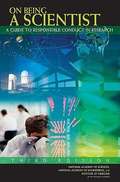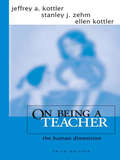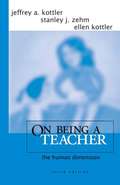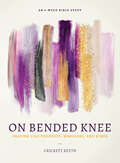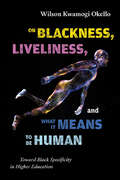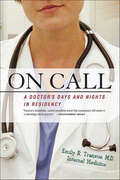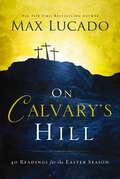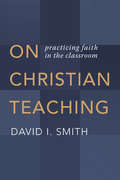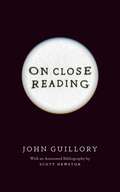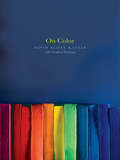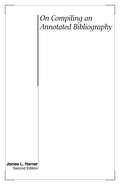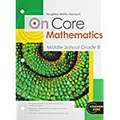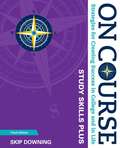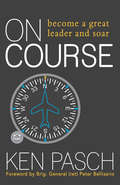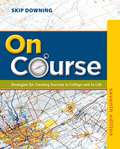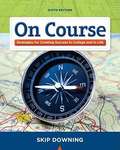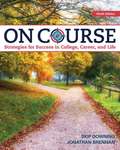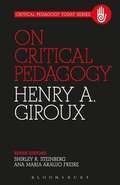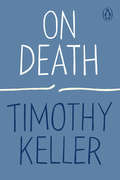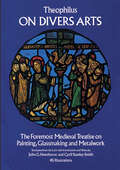- Table View
- List View
On Being a Mentor: A Guide for Higher Education Faculty
by Kimberly A. Griffin W. Brad JohnsonThis third edition of the classic On Being a Mentor is the definitive guide to the art and science of engaging students and faculty in effective mentoring relationships in all academic disciplines.Written for professors and academic leaders with pithy clarity, the text is rooted in the latest research on developmental relationships in higher educational settings and offers concrete mentoring strategies and best practices. On Being a Mentor is infused with an equity-minded approach, and challenges faculty to foster cultures and leverage developmental relationships that honor mentees’ identities to promote inclusion, equity, and belonging. The authors couple this call with evidence-based rules of engagement for mentoring—including both relational and career mentoring tactics—as well as methods for forming and managing these relationships. The authors provide mentors with a road map to being ethical and managing relationship problems, and leaders will gain insights into selecting and training mentors, assessing mentorship outcomes, and cultivating a mentoring culture.Chock full of illustrative case-vignettes, reflection questions, and suggested readings, this book is the ideal guidebook for faculty and a comprehensive training tool for mentoring workshops. It will be a fantastic volume of reference for graduate students in colleges, universities, and professional schools in all academic fields including the social and behavioral sciences, education, natural sciences, humanities, and business, legal, and medical schools.
On Being a Mentor: A Guide for Higher Education Faculty, Second Edition
by W. Brad JohnsonOn Being a Mentor is the definitive guide to the art and science of engaging students and faculty in effective mentoring relationships in all academic disciplines. Written with pithy clarity and rooted in the latest research on developmental relationships in higher educational settings, this essential primer reviews the strategies, guidelines, and best practices for those who want to excel as mentors. Evidence-based advice on the rules of engagement for mentoring, mentor functions, qualities of good mentors, and methods for forming and managing these relationships are provided. Summaries of mentorship relationship phases and guidance for adhering to ethical principles are reviewed along with guidance about mentoring specific populations and those who differ from the mentor in terms of sex and race. Advice about managing problem mentorships, selecting and training mentors, and measuring mentorship outcomes and recommendations for department chairs and deans on how to foster a culture of excellent mentoring in an academic community is provided. Chalk full of illustrative case-vignettes, this book is the ideal training tool for mentoring workshops. Highlights of the new edition include: Introduces a new model for conceptualizing mentoring relationships in the context of the various relationships professors typically develop with students and faculty (ch. 2). Provides guidance for creating a successful mentoring culture and structure within a department or institution (ch. 16). Now includes questions for reflection and discussion and recommended readings at the end of each chapter for those who wish to delve deeper into the content. Best Practices sections highlight the key takeaway messages. The latest research on mentoring in higher education throughout. Part I introduces mentoring in academia and distinguishes mentoring from other types of relationships. The nuts and bolts of good mentoring from the qualities of those who succeed as mentors to the common behaviors of outstanding mentors are the focus of Part II. Guidance in establishing mentorships with students and faculty, the common phases of mentorship, and the ethical principles governing the mentoring enterprise is also provided. Part III addresses the unique issues and answers to successfully mentoring undergraduates, graduate students, and junior faculty members and considers skills required of faculty who mentor across gender and race. Part IV addresses management of dysfunctional mentorships and the documentation of mentorship outcomes. The book concludes with a chapter designed to encourage academic leaders to make high quality mentorship a salient part of the culture in their institutions. Ideal for faculty or career development seminars and teaching and learning centers in colleges and universities, this practical primer is appreciated by professors, department chairs, deans, and graduate students in colleges, universities, and professional schools in all academic fields including the social and behavioral sciences, education, natural sciences, humanities, and business, legal, and medical schools.
On Being a Scientist: A Guide to Responsible Conduct in Research
by Institute of MedicineThe scientific research enterprise is built on a foundation of trust. Scientists trust that the results reported by others are valid. Society trusts that the results of research reflect an honest attempt by scientists to describe the world accurately and without bias. But this trust will endure only if the scientific community devotes itself to exemplifying and transmitting the values associated with ethical scientific conduct. On Being a Scientist was designed to supplement the informal lessons in ethics provided by research supervisors and mentors. The book describes the ethical foundations of scientific practices and some of the personal and professional issues that researchers encounter in their work. It applies to all forms of research--whether in academic, industrial, or governmental settings-and to all scientific disciplines. This third edition of On Being a Scientist reflects developments since the publication of the original edition in 1989 and a second edition in 1995. A continuing feature of this edition is the inclusion of a number of hypothetical scenarios offering guidance in thinking about and discussing these scenarios. On Being a Scientist is aimed primarily at graduate students and beginning researchers, but its lessons apply to all scientists at all stages of their scientific careers.
On Being a Teacher: The Human Dimension
by Ellen Kottler Dr Jeffrey A. Kottler Dr Stanley J. ZehmThe authors help preservice, beginning, and veteran teachers discover their own special traits that make them superlative teachers.
On Being a Teacher: The Human Dimension
by Jeffrey A. Kottler Ellen Kottler Stanley J. ZehmOn Being a Teacher links teaching to the unique human characteristics that each person possesses. Written with the preservice, beginning, and veteran teacher in mind, the authors help educators discover their own special traits that make them superlative teachers. This book covers: Research-based teaching strategies Professional development activities An in-depth look at parent-teacher conferences Ideas for getting involved in your school and district to further professional growth Information on learning styles and multiple intelligences Guides for individual and group reflection This book is ideal for teacher education courses and induction programs and can be used for either individual growth or group study.
On Bended Knee: Praying Like Prophets, Warriors, and Kings
by Crickett KeethWant More From Your Prayer Life?If you&’re dissatisfied in your prayer life, wanting to be more consistent in prayer, or looking to deepen your intimacy with God, then this 8-week Bible study was written for you. It examines the prayers of eight biblical characters and teaches you how to pray like the prayer warriors who went before you. You&’ll study: Jesus: A Model PrayerPaul: A Prayer of IntercessionJob: A Prayer of DespairHannah: A Prayer of LongingDavid: A Prayer of LamentAsa: A Prayer of Seeking GodJehoshaphat: A Prayer of DependenceNehemiah: A Prayer of BoldnessFollow in the footsteps of these spiritual giants and discover anew what our loving God does with a little faith and a whole lot of prayer. You&’ll love studying these scriptural prayers, like the prayer of Asa: Then Asa called to the Lord his God and said, "Lord, there is no one besides You to help in the battle between the powerful and those who have no strength; so help us, O Lord our God, for we trust in You, and in Your name have come against this multitude. O Lord, You are our God; let not man prevail against You." (2 Chron. 14:11)
On Bended Knee: Praying Like Prophets, Warriors, and Kings
by Crickett KeethWant More From Your Prayer Life?If you&’re dissatisfied in your prayer life, wanting to be more consistent in prayer, or looking to deepen your intimacy with God, then this 8-week Bible study was written for you. It examines the prayers of eight biblical characters and teaches you how to pray like the prayer warriors who went before you. You&’ll study: Jesus: A Model PrayerPaul: A Prayer of IntercessionJob: A Prayer of DespairHannah: A Prayer of LongingDavid: A Prayer of LamentAsa: A Prayer of Seeking GodJehoshaphat: A Prayer of DependenceNehemiah: A Prayer of BoldnessFollow in the footsteps of these spiritual giants and discover anew what our loving God does with a little faith and a whole lot of prayer. You&’ll love studying these scriptural prayers, like the prayer of Asa: Then Asa called to the Lord his God and said, "Lord, there is no one besides You to help in the battle between the powerful and those who have no strength; so help us, O Lord our God, for we trust in You, and in Your name have come against this multitude. O Lord, You are our God; let not man prevail against You." (2 Chron. 14:11)
On Blackness, Liveliness, and What It Means to Be Human: Toward Black Specificity in Higher Education (SUNY series, Critical Race Studies in Education)
by Wilson Kwamogi OkelloIn "No Humans Involved: An Open Letter to My Colleagues," Jamaican writer and theorist Sylvia Wynter critiques the social and human sciences for perpetuating social hierarchies, particularly through the Western humanist framing of "Man" as the universal representation of humanity. Human development theories revolve around this concept, necessitating acquiescence to the category Man to claim humanity. But Blackness complicates and unsettles these terms in ways the fields of higher education and educational research are in many ways just beginning to confront.On Blackness, Liveliness, and What It Means to Be Human extends Wynter's critique to human development and academic knowledge production, arguing that Black specificity can create new possibilities for Black being. Wilson Kwamogi Okello closely examines holistic development theory, aiming not to reform but to reimagine the "self" it presupposes. Taking what he describes as a multimodal and multisensory approach, Okello engages a chorus of writers, thinkers, and cultural workers—Baldwin, Bambara, Brand, Hartman, Lorde, Sharpe, Spillers, Wilderson, and more—to reframe Blackness as a social, political, and historical matrix, going beyond the study of Black experiences, biology, or culture. Punctuated throughout by stunning images from artist Mikael Owunna's "Infinite Essence" series, the book proposes and enacts a methodological attunement to Blackness that can guide theory, policy, and practice toward an alternative praxis for the benefit of Black living.
On Call: A Doctor's Days and Nights in Residency
by Emily R. TransueOn Call begins with a newly-minted doctor checking in for her first day of residency--wearing the long white coat of an MD and being called "Doctor" for the first time. Having studied at Yale and Dartmouth, Dr. Emily Transue arrives in Seattle to start her internship in Internal Medicine just after graduating from medical school. This series of loosely interconnected scenes from the author's medical training concludes her residency three years later.During her first week as a student on the medical wards, Dr. Transue watched someone come into the emergency room in cardiac arrest and die. Nothing like this had ever happened to her before-it was a long way from books and labs. So she began to record her experiences as she gained confidence putting her book knowledge to work.The stories focus on the patients Dr. Transue encountered in the hospital, ER and clinic; some are funny and others tragic. They range in scope from brief interactions in the clinic to prolonged relationships during hospitalization. There is a man newly diagnosed with lung cancer who is lyrical about his life on a sunny island far away, and a woman, just released from a breathing machine after nearly dying, who sits up and demands a cup of coffee.Though the book has a great deal of medical content, the focus is more on the stories of the patients' lives and illnesses and the relationships that developed between the patients and the author, and the way both parties grew in the course of these experiences.Along the way, the book describes the life of a resident physician and reflects on the way the medical system treats both its patients and doctors. On Call provides a window into the experience of patients at critical junctures in life and into the author's own experience as a new member of the medical profession.
On Calvary's Hill: 40 Readings for the Easter Season
by Max Lucado Charles F. StanleyIn his last week on Earth, Jesus knew the end was near. He knew the finality of Friday, but did he also know the victory of Sunday? Join bestselling author and pastor Max Lucado invites you to walk with Jesus in the week leading up to the crucifixion: feeling his passion, sensing his authority, and hearing his promise that death has no power.On Calvary's Hill paints a picture of Jesus in his final week: Jesus was commonly dressed but uncommonly focused. Leaving Jericho and walking toward Jerusalem, he doesn't chatter or pause. He's on his final journey. Even the angels are silent. They know this is no ordinary walk or week--hinged on this week is the door of eternity.With excerpts from Max's bestsellers, including 3:16, He Chose the Nails, and Just Like Jesus, On Calvary's Hill will take you into Jesus' last week, from the road to Jerusalem to the resurrection. Each reading includes a timeless verse, an in-depth reading, and a thoughtful prayer designed to help you draw near to the Savior and prepare to celebrate the resurrection--the greatest miracle ever conceived.As we observe Jesus' last week, Max challenges us to face difficult questions, including:When betrayal comes, what can we do?Why is the cross a symbol of Christianity?What would it feel like to witness this scene firsthand?Let's follow Jesus on his final journey. By observing his, we may learn how to make ours.
On Christian Teaching: Practicing Faith in the Classroom
by David I. SmithChristian teachers have long been thinking about what content to teach, but little scholarship has been devoted to how faith forms the actual process of teaching. Is there a way to go beyond Christian perspectives on the subject matter and think about the teaching itself as Christian? In this book David I. Smith shows how faith can and should play a critical role in shaping pedagogy and the learning experience.
On Christian Teaching: Practicing Faith in the Classroom
by David I. SmithChristian teachers have long been thinking about what content to teach, but little scholarship has been devoted to how faith forms the actual process of teaching. Is there a way to go beyond Christian perspectives on the subject matter and think about the teaching itself as Christian? In this book David I. Smith shows how faith can and should play a critical role in shaping pedagogy and the learning experience.
On Close Reading
by John GuilloryJohn Guillory considers close reading within the larger history of reading and writing as cultural techniques. At a time of debate about the future of “English” as a discipline and the fundamental methods of literary study, few terms appear more frequently than “close reading,” now widely regarded as the core practice of literary study. But what exactly is close reading, and where did it come from? Here John Guillory, author of the acclaimed Professing Criticism, takes up two puzzles. First, why did the New Critics—who supposedly made close reading central to literary study—so seldom use the term? And second, why have scholars not been better able to define close reading? For Guillory, these puzzles are intertwined. The literary critics of the interwar period, he argues, weren’t aiming to devise a method of reading at all. These critics were most urgently concerned with establishing the judgment of literature on more rigorous grounds than previously obtained in criticism. Guillory understands close reading as a technique, a particular kind of methodical procedure that can be described but not prescribed, and that is transmitted largely by demonstration and imitation. Guillory’s short book will be essential reading for all college teachers of literature. An annotated bibliography, curated by Scott Newstok, provides a guide to key documents in the history of close reading along with valuable suggestions for further research.
On Color
by David Kastan Stephen FarthingOur lives are saturated by color. We live in a world of vivid colors, and color marks our psychological and social existence. But for all color’s inescapability, we don’t know much about it. <P><P>Now authors David Scott Kastan and Stephen Farthing offer a fresh and imaginative exploration of one of the most intriguing and least understood aspects of everyday experience. Kastan and Farthing, a scholar and a painter, respectively, investigate color from numerous perspectives: literary, historical, cultural, anthropological, philosophical, art historical, political, and scientific. <P> In ten lively and wide-ranging chapters, each devoted to a different color, they examine the various ways colors have shaped and continue to shape our social and moral imaginations. Each individual color becomes the focal point for a consideration of one of the extraordinary ways in which color appears and matters in our lives. <P>Beautifully produced in full color, this book is a remarkably smart, entertaining, and fascinating guide to this elusive topic.
On Compiling an Annotated Bibliography
by James L. HarnerJames Harner's popular pamphlet, first published in 1985, has been revised and updated in the light of advances in computer technology and the availability of humanities databases. Harner offers useful information on planning research, organizing an annotated bibliography, compiling entries, using a computer to prepare the manuscript, and editing. While the booklet focuses on the preparation of a comprehensive bibliography on a single literary author, the procedures and techniques are easily adapted to selective or subject bibliographies and to other periods and disciplines.
On Course Study Skills Plus: Strategies for Creating Success in College and in Life
by Skip DowningOn Course is intended for college students of any age who want to create success in college and in life. Whether students are taking a student success or first-year seminar course, a writing course, or an "inward-looking" course in psychology, self-exploration, or personal growth, On Course is an instruction manual for improving the quality of their outcomes and experiences.
On Course: Become a Great Leader and Soar
by Ken PaschHave you ever had a bad boss? Do you think so many bosses are bad because they&’re &“jerks&” or because they just don&’t know HOW to lead? Bottom line, there are some jerks out there, but Ken Pasch&’s research shows that most bosses are frustrated because they just don&’t know how to lead. That frustration leads to some very bad relationships and outcomes. On Course helps begin turn this around. Unlike so many other books that tell professionals what a good leader should be, On Course is the first step in learning how to become a good leader. The revolutionary model business professionals learn is the result of Ken&’s transition from being one of those bad bosses, years ago, to becoming a successful leader. Don&’t take Ken&’s word for it, listen to the testimonials from others. Then, dive into On Course to discover how you, too, can become a great leader and soar!
On Course: Strategies For Creating Success in College and in Life (Seventh Edition)
by Skip DowningON COURSE: STRATEGIES FOR CREATING SUCCESS IN COLLEGE AND IN LIFE empowers students with the tools they need to take charge of their academic and lifelong success. Through distinctive guided journal entries, Skip Downing encourages students to explore and develop their personal responsibility, self-motivation, interdependence, and self-esteem, and to make wise choices that create successful results. "Wise Choices in College" sections in each chapter help students develop the study skills they need to excel in their other courses. The 7th edition features expanded coverage of diversity, emphasizing the many ways in which people are different and how these differences often influence the choices they make. Other new topics include a discussion of academic integrity, how to thrive in the college culture, and a research-based section on the importance of developing a growth mindset.
On Course: Strategies for Creating Success in College and in Life
by Skip DowningON COURSE: STRATEGIES FOR CREATING SUCCESS IN COLLEGE AND IN LIFE presents a hands-on approach to learning essential life and study skills. Now in its 6th edition, ON COURSE is used as a text in student success courses, first-year experience programs, and inward-looking courses that promote student growth and self-awareness. ON COURSE demonstrates the choices that successful students make. A self-assessment tool at the beginning of the text helps students to identify behaviors and beliefs they may wish to change in order to achieve more of their potential in college and in life. Students have an opportunity to revisit their self-assessment at the conclusion of the text. Written in a positive, motivational style, ON COURSE empowers students with the tools they need to take charge of their success in college and in life. Downing's distinctive guided journal entries help students develop essential life skills by encouraging exploration of personal responsibility, self-motivation, interdependence, and self-esteem. Extensive coverage of study skills--reading, note taking, memory and test taking--provided in the "Wise Choices in College" sections helps students excel in all of their college courses. Students are encouraged by hearing from their peers through a unique feature called "One Student's Story," which highlights the implementation of the text's strategies.
On Course: Strategies for Creating Success in College, Career, and Life
by Skip Downing; Jonathan BrennanThe author encourages you to explore and develop eight keys to your success: personal responsibility, self-motivation, self-management, interdependence, self-awareness, lifelong learning, emotional intelligence, and self-esteem. As you develop these skills, you'll find yourself making more effective choices and achieving greater success.
On Critical Pedagogy
by Henry A. GirouxThis is a sweeping survey of the current state of Critical Pedagogy, offering inspiration to everybody invested in the future of radical educational change. For thirty years Henry Giroux has been theorizing pedagogy as a political, moral, and cultural practice, drawing upon critical discourses that extend from John Dewey and Zygmunt Bauman to Paulo Freire. This impassioned book starts with the crucial role of pedagogy in schools before extending the notion to the educational force of the wider culture.
On Death: On Birth; On Marriage; On Death (How to Find God #3)
by Timothy KellerFrom New York Times bestselling author and pastor Timothy Keller, a book about facing the death of loved ones, as well as our own inevitable deathSignificant events such as birth, marriage, and death are milestones in our lives in which we experience our greatest happiness and our deepest grief. And so it is profoundly important to understand how to approach and experience these occasions with grace, endurance, and joy.In a culture that does its best to deny death, Timothy Keller--theologian and bestselling author--teaches us about facing death with the resources of faith from the Bible. With wisdom and compassion, Keller finds in the Bible an alternative to both despair or denial.A short, powerful book, On Death gives us the tools to understand the meaning of death within God's vision of life.
On Divers Arts (Dover Art Instruction)
by John G. Hawthorne C. S. Smith Theophilus"I have made it my concern to hunt out this technique for your study as I learned it by looking and listening." On Divers Arts, c. 1122, is the oldest extant manual on artistic crafts to be written by a practicing artist. Before Theophilus, manuscripts on the arts came from scholars and philosophers standing outside the actual profession. On Divers Arts describes actual 12th-century techniques in painting, glass, and metalwork, which the Benedictine author wished to pass on to those gifted by God with a talent for making beautiful things. Theophilus teaches, with rigorous attention to fact but also with great reverence the making of pigments for fresco painting, the manufacture of glue, the technique of gold leaf on parchment (the first recorded European reference to true paper), how to blow glass and design stained glass windows, how to fashion gold and silver chalices, and how to make a pipe organ and church bells. Precise instruction on enameling, chasing, repoussé, niello, and beaded wire work prove Theophilus's first-hand knowledge of his craft.While 90 percent of Theophilus's writing is sound technical knowledge, medieval folk lore occasionally spices his text: "Tools are also made harder by hardening them in the urine of a small red-headed boy than by doing so in plain water." But the magnificent fact of On Divers Art remains its status as the first technical treatise on painting, glass, and metalwork, for which actual specimens still survive. The editors have taken care to ensure both philological and technological accuracy for this authoritative edition of a medieval classic, a manual of great importance to craftsmen, historians of art and science, and all who delight in the making of the beautiful.
